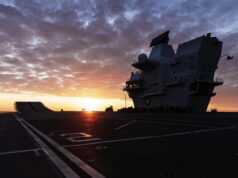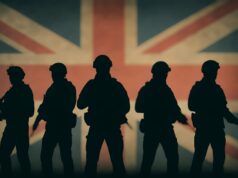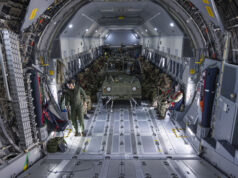The Ministry of Defence has confirmed that trials for the British Army’s Challenger 3 main battle tank are planned to conclude by the end of 2026, according to a written parliamentary answer.
The clarification came in response to a question from Conservative MP Ben Obese-Jecty, who asked when testing would be completed ahead of the tank’s acceptance at its final build standard.
Luke Pollard, Minister of State at the Ministry of Defence, replied on 16 September: “The Challenger 3 trials are currently planned to conclude by the end of 2026. This timeline is subject to ongoing review by the project team to ensure it remains aligned with delivery milestones, operational requirements, and any emerging technical risk.”
The Challenger 3 is the British Army’s next-generation main battle tank, developed by Rheinmetall BAE Systems Land (RBSL), a joint venture between BAE Systems and Germany’s Rheinmetall. The programme will see 148 Challenger 2 tanks upgraded to the Challenger 3 standard, strengthening firepower, protection, and NATO interoperability.
A central change is the replacement of the 120mm rifled gun with the NATO-standard Rheinmetall L55A1 120mm smoothbore cannon, which allows the use of advanced programmable ammunition. Other upgrades include a redesigned turret, modern thermal imaging sights, improved hydrogas suspension, enhanced engine cooling, and the integration of the Trophy active protection system alongside Elbit’s laser warning system.
According to the MOD, four prototypes have already been delivered, with four more in production. Trials are set to continue through 2025, with initial operational capability expected in 2027 and full operational capability by 2030. The programme has experienced supply chain delays and budgetary pressures, but officials stress its role in modernising the Army’s armoured fleet.
The Challenger 3 is intended to overcome the shortcomings of Challenger 2 by increasing lethality, survivability, and situational awareness. With its new gun, sensors, and protection systems, it is designed to counter modern battlefield threats more effectively while remaining interoperable with allied forces.














I know that the Army is at the bottom of the priority list, but having only 148 MBTs over an entire division just isn’t going to cut it in any conflict against a near peer enemy. Same with RA not gaving enough guns. It seems to me that somehow the MOD wants us to fight a war without attrition for the small amount of heavy equipment we have left.
UGV as per loyal wingman concept and as stand alone Infantry tools are how to increase lethality, lower risk, and add scale to Armoured formations.
AFU has already proven UGV is not just a logistics (in) and medical (out) tool, but able to deliver effect to the enemy.
Automation and aerial relay is enabling valuable results at lower risk and cost than premium MBTs.
She looks brutal in the latest videos, featuring new additional armour panels on the turret and driver area. The odds are she will be all the Army needs following on from the mighty CH2. Sadly, we should be getting more, but we all know the answer to that one.
Let’s give it a couple of years in service to garner feedback and then start a Challenger 4 development programme based on the C3 but from scratch, a new build incorporating feedback.
148 isn’t enough but the engineering could presumably form the basis for a new build package.
Testing efforts are incomplete without trials with AFU ideally Magyars Birds 🐦 to check that Trophy is really up to the job of UAV protection.
Presumably it’s already tested against NLAW top attack that was such a turret toss enabler on the road to Kyiv 2022.
#StrongerTogether
#vpdfo FDJT
Nath, Intuitively I feel that CR4 should not be evolutionary from CR3, but revolutionary with much reduced signature/weight, duced logistic tail and perhaps a very different Main Armament such as 130mm conventional gun or EM rail gun or other novel technology, and very capable DAS.
How on earth, in a time when the Service Chiefs are saying we are preparing for war, does it take 18 months (maybe more) to trial a new(ish) tank? At the end of the trial they will probably conclude it needs a larger engine which was apparent at least 5 years ago.
Because we aren’t at war and fixing issues post trials is much more expensive in. £ and lives than having a thorough trials period.
If only they painted them Black, they look at least ten times as lethal in black.
With a red strip to make them go faster.
How many cans ?
About five normally loosens the foot 😂
No rush, we can always hope Vlad slows down production of new T-90Ms (which is currently about 25 per month)
Russia also refurbishes about 90-100 T62/T72/T80 tanks per month from storage.
These figures are declining now as attritional losses bite, but you see what we are up against when it comes to creating mass/reserves.
Thing is we wouldn’t be using tanks to take out tanks.
That is a missile job shortly to be a missile from drone job.
That is not my point.
In attritional warfare (which would be the case in any confrontation with CRINK countries).
We will need mass and the ability to rapidly procure and maintain at mass levels.
By the time we finish testing CH3 Russia will have rolled out 250 – 300 T-90Ms, plus however many refurbished tanks.
They will need a lot less drones and missiles to take out our tanks
CRINK countries have a luxury we don’t: manpower. We can’t afford to use tanks and their crews as drone fodder so we have to use our gdp per capita advantage to find a technological solution.
Yeah, but whatever we use to counter CRINK our research and industries need to gear up, we can’t afford to take 2 years to test new designs.
What are these tanks FOR?
Direct fires in support of combined arms action.
And production capacity across ENATO is?
A pity HMG do not appear to be able, or even willing, to squeeze a few more out of existing numbers.
Maybe those stored are in a worse state than was reported.
Around current numbers, 200 or so, would do just fine in my opinion, given how the Army is set up, just 3 Regiments for MBT, and extras for training, trials, maintenance, and a some reserve. They are cheap too, as J has observed many times.
The ghost of Whitehall debates as to whether the MBT was dead or alive lives on, and CH3 suffered as a result. All that nonsense killed MBT development and manufacture of heavy armour in the UK and now it’s all come home to roost. A CH3 replacement will probably be licensed built in the UK to a foreign design with little chance of a standalone design being developed and manufactured in Britain.
Now that Germany and UK have agreement in place, surely time for a Leopard 3 programme for all the integration, sensor fusion and automation required to dominate the UAV UGV battle space, not just be able to defend against UAV (CH3)?
#StrongerTogether #EuropeFirst
I reckon the Army wanted Leopard 2 all along so ending up with a licence built Leopard 3 is an all round optimal outcome.
Rob, There are some serious doubts about Leo2 survivability in combat in several theatres.
Rhienmettal have said the jigs exist to build more Challenger hulls if required,this turret is supposedly designed to be upgraded if and when so the capability to build here should be there?
My question is: How do our tanks differ from anyone else’s tanks in terms of hull integrity?
Russia has taken 1000s of old hulls, stored in the open, and refurbished them.
The US, has refurbished/upgraded 400 Abrams this year.
Do all of the remaining spare 71 CH2 hulls have structural fatigue?
What are we doing differently?
I don’t know.
All I know is the photos I saw of CH2 at Ashchurch rusting away as they were in hangers in effect open with the state they were in.
There is CHE storage, but unsure if we kept any in those buildings.
And the US has the Boneyard.
Russia? It’s a good question!
According to the satellite images, the RF Soviet stockpiles are massively depleted leaving just residual marks on the ground and showing that they had just been parked on flat ground, nothing more.
Consistent with the Strategic bomber fleet storage at airbases, without HAS just some old tyres on the wings. That’s a long way from aerospace level storage and no restraint on UAV operations as Op Spideŕweb showed.
Further the weather conditions are brutal (+30°c to -30°c) so that rust over decades of storage is a certainty.
For USA storage, the Boneyard has very dry and relatively stable ambient temperature so is aerospace friendly. The process to reclaim condition and return to service has been proven though IDK cost.
Not sure where the Bradley and Abrams fleets are stored. Don’t remember seeing them at DMA Boneyard being USAF..
The question is how long and how much for. Russia yes left a ton of vehicles to rust for decades, but now theyve basically said “get them running at any cost”. RBSL is asking 5mil per unit and I doubt will want to make a loss on vehicles that need more work.
Indeed. The ‘purchasing power’ of the RF dictatorship is very different to any western democratic economy. When the dictator says JFDI neither the defence companies nor their serfs are able to disagree.
Not that I’m suggesting Modern Slavery is how western defence industry should be run, nor that the end result are comparable. Soviet era armour hull refurbishment isn’t going to correct the turret toss problem, and the UAV countermeasures don’t seem to be working either.
From an engineering and commercial perspective, a new build is more certain and efficient than refurbishment to resolve unknown issues. Worst case scenario pricing is prudent from the supplier, unfortunately.
I honestly don’t understand how they are going to manage with 148 now they have clearly decided to keep 3 MBT regiments. I would imagine the thinking is to move to a type 44 or 38 regiment but even 3 type 44 regiments would require 132 MBTs deployed.. if you have 18 for the training establishment, 18 as an attritional reserve and 10% for maintenance pool that is 185 MBTs… going to type 38 regiments would maybe take you down to needing 165 MBTs but in no rational reality can you maintain 3 MBT regiments with 148 MBTs… remembering those figures only give you a 1 squadron attritional reserve across all three regiments.. as an example of how low this in WW2 the British army kept an in theatre 100% attritional reserve. Essentially if you loaded a point class up with a squadron for an exercise and for some reason that ship foundered ( and many ships do every year) you have lost your entire attritional reserve….so 200 would be better for type 44 regiments and 250 for three type 56 regiments.
No rush, 148 Tanks that will be enough as long none get took out or brake down, our Army really is all on shoe string budget. Just enough no more. Though will there ever be a future large tank battle? As far I know there was only one tank battle so far in the Ukraine war. Drones etc are making life hard for a tank. Just might be that our Army is ahead of the game in not having too many? Its that or we can not afford any more.
Martin, tanks are not just for tank battles any more than destroyers are not just for destroyer battles. Tanks deliver fire support or long range fires in support of combined arms operations. Their targets can be tanks and tank variants, medium armour, strongpoints and light armour if required albeit that’s overkill. They can also operate in COIN as a Show of Force measure.
This. But also what is even meant by “Tank battle”? Doctrinally the tank hasn’t been a primary AT weapon since 1942, so if that’s whats meant then we’ve not seen a tank battle since ww2. If a tank battle is a battle in which armoured formations preform a large portion of breakthrough, defense or maneuver, then we’ve seen several, both defensive and offensive, successful and unsuccessful in Ukraine alone.
Every man and his dog knows 148 tanks is a joke and this was decided not by a failed MOD but by the treasury deciding how little it could get away with. This government talks about increases in Defence spending but makes sure it will be as slow as it can be before Trump calls them out. Let’s face it we are skint.
What is happening with Oman’s Challenger 2’s?